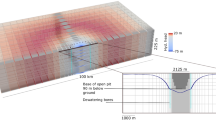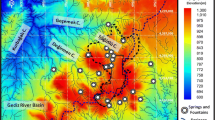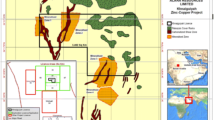Abstract
Increasingly, mine issues and water resources are being managed on a watershed basis, while addressing problems at the local mine scale. A good example of this developed when empirical and analytical modelling of the potential inflow to an open pit mine in the Durvuljin soum, a region in northwest Mongolia, indicated that inflow would be on the order of 0.3 to 10.5 L/s. In this study, the radius of influence due to open pit mining was estimated to be between 0.6 and 3 km. Based on simulated drawdown contours and transient pit inflow figures that captured the impact of mining and groundwater inflow rate variations over a period of time, it appeared that advanced dewatering will not be required at this mine, unless currently unknown major fractured structures are intercepted. In-pit basal sumps and pumps should be sufficient to remove water from the mine floor. However, an assessment of the final pit level is also crucial to planning the post-mining surface and groundwater quality/eco-system and mitigation requirements during recovery. Our post-mining water table recovery estimate indicated that inflow will exceed evaporation and that a shallow lake will likely form. While such solutions, which do not rely on complex numerical models nor excessive input data, are not appropriate for all hydrogeologic situations, they are relevant to the conditions encountered at most mine sites.
Zusammenfassung
Bergbau und Wasserressourcen werden zunehmend im Maßstab der Einzugsgebiete bewirtschaftet, während Probleme im lokalen Bergbaumaßstab geregelt werden. Ein derartiges Beispiel zeigte sich bei empririschem und analytischem Modellieren des möglichen Wasserzulaufs in einen Tagbau in dem Durvuljin soum, einer Region in der nordwestlichen Mongolei. Demnach würde der Zulauf zwischen 0.3 und 10.5 L/s liegen. Der Radius des Absenkungstrichters wurde in dieser Studie auf 0.6 bis 3 km geschätzt. Simulierte Konturen des Trichters und transiente Zulaufvolumina erfassten die Auswirkung des Bergbaues und wechselnder Zuflussraten über die Zeit. Daraus ergab sich, dass bei diesem Bergbau keine Vorausentwässerung notwendig sein würde, wenn nicht derzeit unbekannte Störungen angeschnitten werden. Sümpfe und Pumpen sollte ausreichen, um Wasser von der Tagbausohle zu entfernen. Auch eine Abschätzung der Endteufe des Tagebauloches ist erforderlich, um die Qualität, Ökosysteme und Schadensminderung der Bergbaufolgelandschaft und des Grundwassers während der Aufspiegelung zu planen. Der Zufluss wird die Verdunstung übertreffen und vermutlich wird sich ein seichter See bilden. Obwohl derartige Lösungen, welche nicht auf komplexen numerischen Modellen und grossen Datenmengen beruhen, nicht für alle hydrogeologischen Gegebenheiten geeignet sind, können sie für die meisten Bergbaue sachdienlich sein.
Resumen
En forma creciente las situaciones en las minas y las reservas hídricas están siendo manejadas sobre la base de las cuencas en lugar del abordaje local en la mina. Un buen ejemplo de esto se desarrolló modelando, en forma empírica y analítica, la potencial irrupción de agua en una mina de cielo abierto en Durvuljin, una región en el noroeste de Mongolia; los resultados indicaron que la entrada de agua debía ser del orden de 0.3 a 10.5 L/s. En este estudio se estimó el radio de influencia de la minería a cielo abierto entre 0.6 y 3 km. Sobre la base de los contornos simulados y las figuras de irrupción transientes generadas por el impacto de la minería y las variaciones del flujo de entrada de agua subterránea sobre un período de tiempo, se encontró que no se requerirán desagotes avanzados en esta mina salvo que se intercepten estructuras fracturadas no conocidas actualmente. Los sumideros basales dentro del hoyo y las bombas deberían ser suficientes para eliminar el agua del piso de la mina. Sin embargo, una evaluación del nivel final en el hoyo es crucial para la planificación de los requisitos de la superficie post minería, de la calidad y ecosistema de las aguas subterráneas y de los requerimientos de mitigación durante la recuperación. Nuestra tabla de estimación de recuperación post minería, indicó que la entrada superará la evaporación y que probablemente se formará un lago poco profundo. Estas soluciones que no se basan en modelos numéricos complejos ni en excesivos datos de entrada, no son apropiadas para todas las situaciones hidrogeológicas, pero son relevantes en las condiciones encontradas en la mayoría de los sitios mineros.
蒙古Zavkhan省Durvuljin soum露天矿涌水量与采后水位恢复预测
目前人们越来越重视在流域尺度进行采矿与水资源协调管理和在局部小尺度解决采矿问题。例如,经验模型和解析模型预测蒙古西北部Durviljin soum露天预测涌水量为0.3 ~ 10.5 L/s,露天矿影响半径为0.6 ~ 3km。同时,降深预测和非稳定流涌水量计算表明,除非采矿揭露未知大型断裂,开采期间将不需要进一步疏水。露天矿坑内水仓和水泵应该具有足够抽排矿坑水的能力。矿坑采后最终地下水位对采后地表水和地下水质恢复及生态恢复非常关键。采后水位恢复估算结果表明,矿坑涌水量将超过蒸发量并形成地表浅湖。虽然不依赖复杂数值模型和大量数据输入的经验与解析解并不一定适用于所有矿坑,但该解对绝大多数矿坑是可靠的。.






Similar content being viewed by others
References
Barker JA (1988) A generalized radial flow model for hydraulic tests in fractured rock. Water Resour Res 24(10):1796–1804
Battumur (2009) Assessment of Water Supply Options for Proposed Bayan Airag Gold-Copper Mine. Report: January 2009
Bredehoeft J (2005) The conceptualization model problem-surprise. Hydrogeol J 13:37–46
Dragoni W (1998) Some consideration regarding the radius of influence of a pumping well. Perugia, Italy. http://www.unipq.it/~denz/Dragoni.pdf
Fitts CR (2010) Modeling aquifer systems with analytic elements and subdomains. Water Resour Res 46:W07521. doi:10.1029/2009WR008331
Hasiniaina F, Zhou J, Guoyi L (2010) Regional assessment of groundwater vulnerability in Tamtsag Basin, Mongolia using drastic model. J Am Sci 6(11):65–78
Kazemi GA (2012) Hydrogeology—A Global Perspective. InTech Publ Co, Rijeka, ISBN 978-953-51-0048-5
Li W, Liu Z, Guo H, Li N, Kang W (2011) Simulation of groundwater fall caused by geological discontinuities. Hydrogeol J 19:1121–1133
Marinelli F, Niccoli, WL (2000) Simple analytical equations for estimating ground water inflow to a mine pit. Groundwater 38(2):311–314
Mengistu H, Tessema A, Abiye T, Demlie M, Lin H (2015) Numerical modeling and environmental isotope methods in integrated mine-water management: a case study from the Witwatersrand basin, South Africa. Hydrogeol J 23(3):533–550
Rapanova N, Grmela A, Vojtek D, Halir J, Michalek B (2007) Groundwater flow modelling applications in mining hydrogeology. Mine Water Environ 26:264–270
Rupp DE, Schmidt J, Woods RA, Bidwell VJ (2009) Analytical assessment and parameter estimation of a low-dimensional groundwater model. J Hydrol 377:143–154
Sellers PJ, Meeson BW, Closs J, Collatz J, Corprew F, Hall FG, Kerr Y, Koster R, Kos S, Mitchell K, McManus J, Myers D, Sun KJ, Try P (1995) An overview of the ISLSCP Initiative I global Data Sets, ISLSCP Initiative I Global Data Sets for Land–Atmosphere Models, CD-ROM, Vol 1–5, NASA
Singh VP, Woolhiser DA (2002) Mathematical modelling of watershed hydrology. J Hydrol Eng 7:270–292
Sloan WT (2000) A physics-based function for modelling transient groundwater discharge at the watershed scale. Water Resour Res 36:225–242
SMEC (2011) Bayan Airag Gold Project Pre-Feasibility Level Mine Water Supply Assessment. For: Bayan Airag Exploration LLC
SMEC (2012) Bayan Airag Gold Project Feasibility Level Mine Water Supply Assessment. For: Bayan Airag Exploration LLC
Soni AK, Sahoo LK, Ghosh UK (2015) Importance of radius of influence and its estimation in a limestone quarry. J Inst Eng D 96(1):77–83
Tammetta P (2013) Estimation of the height of complete groundwater drainage above mined longwall panels. Groundwater 51(5):723–734
Toran L, Bradbury KR (1988) Groundwater flow model of drawdown and recovery near an underground mine. Groundwater 26(6):724–733
Vandenbohede A, Hinsby K, Courtens C, Lebbe L (2011) Flow and transport model of a polder area in the Belgian coastal plain: example of data integration. Hydrogeol J 19:1599–1615
Voss CI (2011) Groundwater modelling fantasies-part 1, adrift in the details. Hydrogeol J 19:1281–1284
Wu JC, Zeng XK (2013) Review of the uncertainty analysis of groundwater numerical simulations. Chin Sci Bull 58:3044–3052. doi:10.1007/s11434-013-5950-8
Yihdego Y, Danis C, Paffard A (2015) 3-D numerical groundwater flow simulation for geological discontinuities in the Unkheltseg Basin, Mongolia. Environ Earth Sci J 73(8):4119–4133. doi:10.1007/s12665-014-3697-4
Acknowledgments
The authors thank Bill Colvin and the staff of Bayan Airag Exploration LLC for providing permission to publish this work and in the undertaking of the fieldwork. The manuscript has benefitted from the reviewers’ and editors’ comments.
Author information
Authors and Affiliations
Corresponding author
Rights and permissions
About this article
Cite this article
Yihdego, Y., Paffard, A. Predicting Open Pit Mine Inflow and Recovery Depth in the Durvuljin soum, Zavkhan Province, Mongolia. Mine Water Environ 36, 114–123 (2017). https://doi.org/10.1007/s10230-016-0419-z
Received:
Accepted:
Published:
Issue Date:
DOI: https://doi.org/10.1007/s10230-016-0419-z




